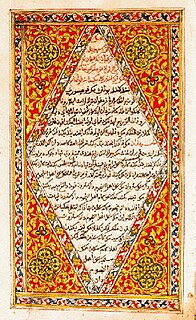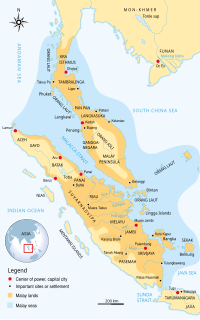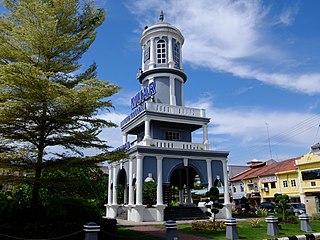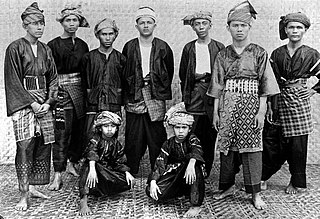
Malaysia is located on a strategic sea lane that exposes it to global trade and various cultures. Strictly, the name "Malaysia" is a modern concept, created in the second half of the 20th century. However, contemporary Malaysia regards the entire history of Malaya and Borneo, spanning thousands of years back to prehistoric times, as its own history, and as such, it is treated on this page.

The Malacca Sultanate was a Malay sultanate centred in the modern-day state of Malacca, Malaysia. Conventional historical thesis marks c. 1400 as the founding year of the sultanate by an Parameswara King of Singapore, Parameswara, also known as Iskandar Shah(after converted to Islam). At the height of the sultanate's power in the 15th century, its capital grew into one of the most important transshipment ports of its time, with territory covering much of the Malay Peninsula, the Riau Islands and a significant portion of the northern coast of Sumatra in present-day Indonesia.

Hang Tuah was a warrior who lived in Malacca during the reign of Sultan Mansur Shah in the 15th century. He was supposedly the most powerful of all the laksamana, or admirals, and is considered by the Malays to be one of history's greatest silat masters. Hang Tuah is held in the highest regard, even in present-day Malay culture, and is arguably the most well-known and illustrious warrior figure in Malay history and literature.

The Malay Annals, originally titled Sulalatus Salatin, is a literary work that gives a romanticised history of the origin, evolution and demise of the great Malay maritime empire, the Malacca Sultanate. The work which was composed sometime between the 15th and 16th centuries, is considered one of the finest literary and historical works in the Malay language.

Kota Gelanggi is an archaeological site reported in 2005 and dating to around 650–900 and one of the oldest Kingdoms on South East Asia's Malay Peninsula. The site's existence was announced as a 'discovery' by the Malaysian press on 3 February 2005.

Malacca City is the capital city of the Malaysian state of Malacca. As of 2019 it has a population of 579,000. It is the oldest Malaysian city on the Straits of Malacca, having become a successful entrepôt in the era of the Malacca Sultanate. The present-day city was founded by Parameswara, a Sumatran prince who escaped to the Malay Peninsula when Srivijaya fell to the Majapahit. Following the establishment of the Malacca Sultanate, the city drew the attention of traders from the Middle East, South Asia, and East Asia, as well as the Portuguese, who intended to dominate the trade route in Asia. After Malacca was conquered by Portugal, the city became an area of conflict when the sultanates of Aceh and Johor attempted to take control from the Portuguese.

The Johor Sultanate was founded by Malaccan Sultan Mahmud Shah's son, Sultan Alauddin Riayat Shah II in 1528. Johor was part of the Malaccan Sultanate before the Portuguese conquered Malacca's capital in 1511. At its height, the sultanate controlled modern-day Johor, Riau, and territories stretching from the river Klang to the Linggi and Tanjung Tuan, Muar, Batu Pahat, Singapore, Pulau Tinggi and other islands off the east coast of the Malay peninsula, the Karimun islands, the islands of Bintan, Bulang, Lingga and Bunguran, and Bengkalis, Kampar and Siak in Sumatra. During the colonial era, the mainland part was administered by the British, and the insular part by the Dutch, thus breaking up the sultanate into Johor and Riau. In 1946, the British section became part of the Malayan Union. Two years later, it joined the Federation of Malaya and subsequently, the Federation of Malaysia in 1963. In 1949, the Dutch section became part of Indonesia.

Sultan Ali Iskandar Shah ibni Hussein Muazzam Shah was the 19th Sultan of Johor, who succeeded his father, Sultan Hussein after the latter died of natural cause in 1835. Over the next twenty years, Sultan Ali's claims to the office of Sultan of Johor were only recognised by some merchants and a few Malays. Like his father, Sultan Ali's was much of a puppet monarch and played a minimal role in the administrative affairs of the state, which came under the charge of the Temenggong and the British. In 1855, Sultan Ali ceded the sovereignty rights of Johor to Temenggong Daeng Ibrahim, in exchange for a formal recognition as the "Sultan of Johor" by the British and a monthly allowance. Following the secession of Johor, Sultan Ali was granted administrative charge over Muar until his death in 1877, and in most administrative matters, was often styled as the "Sultan of Muar".
Kota Buruk, literally meaning "Fort of Ruins" in Malay, is a historic site believed to be located at today's Kampung Tanjung Selabu, Jorak, Sungai Terap, Bukit Pasir, Pagoh, Muar, Johor, Malaysia. This site purportedly said to be identified as the original Kota Buruk location and is being preserved as a historic place for the public to visit. Nearby, another historic site, the fort of Biawak Busuk, is believed to be located.

The early history of Singapore refers to its pre-colonial era before 1819, when the British East India Company was led by Sir Stamford Raffles established a trading settlement on the island and set in motion the history of Singapore.

The Melayu Kingdom was a classical Buddhist kingdom located in Southeast Asia.
Tun Muhammad bin Tun Ahmad, better known as Tun Sri Lanang, was the Bendahara of the royal Court of Johor Sultanate who lived between the 16th and 17th centuries. He served under two Sultans of Johor, namely; Sultan Ali Jalla Abdul Jalil Shah II (1570–1597) and Sultan Alauddin Riayat Shah III (1597–1615) and also advisers to 3 Acheh sultans namely; Sultan Iskandar Muda, Sultan Iskandar Thani (1636–1641) and Sultana Tajul Alam Safiatuddin Shah (1641–1675). He had two honorific titles throughout his lifetime; as the Bendahara of Johor, Bendahara Paduka Raja Tun Mohamad, while he was given the title of Orang Kaya Dato' Bendahara Seri Paduka Tun Seberang after settling in Aceh.

Muar or Bandar Maharani, is a historical town and the capital of Muar District, Johor, Malaysia. It is one of the most popular tourist attractions in Malaysia to be visited and explored for its food, coffee and historical prewar buildings. It was recently declared as the royal town of Johor by Sultan Ibrahim Sultan Iskandar and is the fourth largest city in Johor. It is the main and biggest town of the bigger entity region or area of the same name, Muar which is sub-divided into the Muar district and the new Tangkak district, which was upgraded into a full-fledged district from the Tangkak sub-district earlier. Muar district as the only district covering the whole area formerly borders Malacca in the northern part. Upon the upgrading of Tangkak district, the Muar district now covers only the area south of Sungai Muar, whilst the northern area beyond the river is in within Tangkak district. However, both divided administrative districts are still collectively and fondly called and referred to as the region or area of Muar as a whole by their residents and outsiders. Currently, the new township of Muar is located in the Bakri area.

Malaysia–Thailand relations refers to bilateral foreign relations between the two countries, Malaysia and Thailand. Thailand has an embassy in Kuala Lumpur, and consulate-general offices in George Town and Kota Bharu. Malaysia maintains an embassy in Bangkok.

Parameswara, thought to be the same person named in the Malay Annals as Iskandar Shah, was the last king of Singapura and the founder of Malacca. According to the Malay Annals, he ruled Singapura from 1389 to 1398. The king fled the island kingdom after a Majapahit naval invasion in 1398 and founded his new stronghold on the mouth of Bertam river in 1402. Within decades, the new city grew rapidly to become the capital of the Malacca Sultanate. Portuguese accounts, written a hundred years after his death, however, suggest he was from Palembang and usurped the throne of Singapura before he was driven out, either by the Siamese or the Majapahit, and founded Malacca.
Negeri Sembilan Malay is an Austronesian language spoken mainly in the Malaysian state of Negeri Sembilan and in northern Malacca in Alor Gajah. The language is spoken by the descendants of Minangkabau settlers from Sumatra, who have migrated to Negeri Sembilan since as early as the 14th century. It is often considered a variant or dialect of the Minangkabau language; lexical and phonological studies, however, indicate that it is more closely related to Standard Malay than it is to Minangkabau.

The Kingdom of Singapura was a historical Malay kingdom thought to have been established on the main island of Singapore, from 1299 to 1398. Conventional view marks c. 1299 as the founding year of the kingdom by Sang Nila Utama, whose father is Sang Sapurba, a semi-divine figure who according to legend is the ancestor of several Malay monarchs in the Malay World. The historicity of this kingdom, based on the account given in the Malay Annals, is the subject of academic debates, and many historians only consider its last ruler Parameswara a historically attested figure. Archaeological evidence from Fort Canning Hill and the nearby banks of the Singapore River has nevertheless demonstrated the existence of a thriving settlement and a trade port in the 14th century.
Sri Maharaja Sang Sapurba Paduka Sri Trimurti Tri Buana, (1245-1316) also known as Sri Nila Pahlawan, is a figure in the Malay Annals, highly revered as the legendary great ancestor of some of the major dynasties of the Malay world: Singapura, Malacca, Pahang, Johor, Perak, Kelantan, Terengganu and Siak Sri Indrapura. Legend has it that after his accession to Seguntang Hill with his two younger brothers, Sang Sapurba enters into a sacred covenant with Demang Lebar Daun the native ruler of Palembang, which laid the basis of the proper relationship between the Malay rulers and the subjects. The legendary sword believed to be carried by the king, the Cura Si Manjakini, is now formed part of the regalia of Perak Sultanate, whose rulers are said directly descended from the king. The details of Sang Sapurba stories are mainly composed of folklore and legends, and thus his historical existence is debated and disputed by modern historians. Even so, as De Jong argued in her article The Character of Malay Annals, the stories of the Malay Annals could have been realistically mixed with the historical figures and events.

Tengkolok, also known as Tanjak, Destar is a traditional Indonesian and Malay male headgear. It is made from long songket cloth folded and tied in particular style (solek). Nowadays, it is usually worn in ceremonious functions, such as royal ceremony by royalties, and wedding ceremony by grooms.













